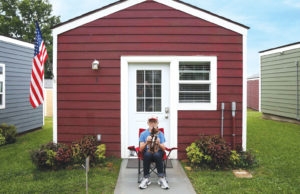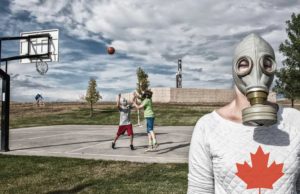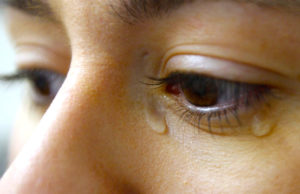Blackened pots bubbled with suppers of rice and
beans above glowing charcoal. Sheets, cardboard mats and mattresses
were laid neatly on the streets; a lucky few pitched pup tents. Chunks
of rubble blocked roads to protect al-fresco sleepers from passing
motorists.
The magnitude 7.0 earthquake that struck
During the day, the estimated 1 million people
remaining in the capital chipped away at crumbled homes, stand in long
lines to get money from banks or relatives overseas, scrounge for food
and occasionally seek shade in structures still standing.
But at nightfall, the rich and the poor, those with
homes and those without, make a giant migration beneath the stars and
into the streets. On Sunday, a moderate aftershock at dusk was a gentle
reminder of the danger, not that they needed one.
On rue Daine, a narrow street in the Delmas area, a
tight-knit neighborhood of four extended families — more than 75 people
in all — pitched in Sunday to prepare their street for the night.
A few young women poured water onto the pavement to
damp down the powdery white dust. Chairs were moved onto the pavement
along with pads, mattresses, sheets and pillows.
bodies from the rubble. Ulna Nerdieu was doing her cousin Alice’s hair.
And a dozen small children raced around laughing.
“Every time we go inside any house, we’re afraid the
earth is going to move,” said Sulface Juslai, 37. His two-story house,
home to 30 family members, had collapsed and tilted precariously behind
him. His cousin, who had been on the ground floor, was the only person
in the building who died.
Juslai’s biggest concern, and a major worry of
everyone on the street, was security — especially with the collapse of
the prisons and the escape of prisoners. A few days earlier, a band of
thieves had come to rue Daine and fired a gun, but the residents ran
and nothing was taken.
After that, Juslai and the other adults armed
themselves with machetes and began taking turns keeping watch at night.
“We don’t sleep well at all,” he said. “We too worried.”
Most of the families on rue Daine have some food,
which they share. One family was eating bowls of boiled plantains and
rice, which a relief agency had dropped off earlier in the day.
Juslai’s family has been eating from their pantry,
but the grits they prepared Sunday morning exhausted their supplies. An
aunt in
Near Juslai, a television set sat atop a wooden
crate. He said the family brought it out of a neighbor’s house, hoping
to watch the global “Hope for
The fears of another major trembler are real, even for those in homes not damaged by the
The U.S. Geological Survey issued a preliminary assessment last week, concluding aftershocks in
are likely to continue for months and possibly years — and that, over
the next 30 days, the probability of a magnitude 6 or greater quake was
1 in 4. The chance of a magnitude 5 or greater quake in that period was
90 percent.
The government has encouraged residents to sleep on the streets until their homes can be tested for structural integrity.
“We all have to take precautions,” said
the Haitian culture and communications minister. “If you are sleeping
in the street, stay together. We’ll do our best to get tests very soon.”
“Our priority is food and water,” she added. “But what people need most is to be in their homes and not on the street.”
On rue Daine, Juslai’s neighbor
58, was sitting on a sofa on the road Sunday, feeding spoonfuls of a
rice stew to two shirtless toddlers, the youngest of his 12 children.
“It’s difficult to be like this,” said Lafaille. “This is the first time in our lives that we’ve had to live on the street.”
—
(c) 2010, Los Angeles Times.
Visit the Los Angeles Times on the Internet at http://www.latimes.com/
Distributed by McClatchy-Tribune Information Services.













